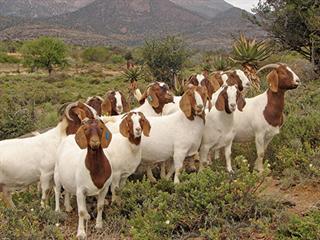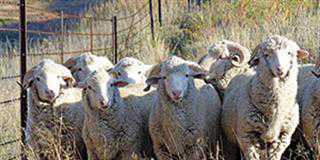
Red meat consumption is under pressure due to tough economic conditions, and the rising cost of living is forcing households to spend increasingly less on this staple. The situation is exacerbated for SA farmers by imports from Namibia.
This is the opinion of Kobus Lotter of Willowmore in the south-eastern Karoo, well-known Boer Goat farmer, founder member of the Quattro Boer Goat Group and international Boer Goat show judge. “At the same time, new entrants into the farming sector, including weekend farmers, are helping to flood the market. But the supply and demand wheel will turn, as it always does,” he says.
On the other hand, the much-discussed market for certain cuts of goat meat to be sold in supermarkets can only be developed if there is a consistent oversupply for an extended period. Until then, stresses Kobus, the sale of live animals will continue to dominate. The majority of animals are sold in KwaZulu-Natal at a weight of between 16kg and 35kg.
Current market conditions have led to an increase in intensive goat-rearing enterprises. Kobus contends, however, that feedlot-raising of Boer Goats, or any other breeds developed for extensive conditions pays, only on paper. “Most intensive operations are only temporary, because parasites and diseases, which flourish under such conditions, eventually win.”
He concedes that ‘lifestyle farmers’, who have made their money elsewhere, are sometimes successful with small-scale intensive goat farming. But larger stud breeders and those getting above-average prices for their stock usually farm on a semi-intensive basis, combining veld and supplementary feeding. “I doubt whether commercial Boer Goat farmers in South Africa can successfully produce red meat under intensive systems,” he says.
Goats, for example, like to browse standing on their hind legs and are not bred to feed from a bag. “In Australia, I visited an intensive goat farm where the flock was fed green feed produced in fodder production units. Eventually these animals destroyed an entire blue gum forest to satisfy their need for fibre.”

The Quattro team (from left): Johnny Henderson (Toekomst, Somerset East), Vaatjie Nell (Geelhoutboom, Somerset East), Kobus Lotter (Doornpoort, Willowmore) and Sakkie Nell (Brakrivier, Jansenville).
Comparison
Kobus’s first-hand experience of Boer Goats includes being a judge at goat shows in the USA.“In that country, some breeders have bred Boer Goats that resemble whippet dogs – long necks, high in the leg, with no body depth,” he explains. “They have little meat value and are kept for show purposes. They’re very popular with youngsters, In fact, show wethers sell for big money.”
By comparison, Australia’s Boer Goats, most of which are exported to the East, South America and Mexico, compare well with those in South Africa. The breeders, however, have fewer good animals and urgently need new breeding material, which they can get only from South Africa.
Kobus explains that farmers in Reunion, east of Madagascar, are also keen to upgrade their flocks. They have only about 20 000 goats and SA judges travel to the island to judge their shows and help them with selection. On Reunion, goats are slaughtered for ritual and ceremonial purposes.
Export restriction
Currently, SA breeders are badly hampered by the foot-and-mouth protocol. We cannot export anything to Australia or Europe – no live animals, nor semen or embryos. As a result, the industry loses millions,” he explains. But, unlike many other farmers, Kobus is not worried that South Africa’s Boer Goat genetics will be hijacked by other countries.
“Everyone knows the Boer Goat is ‘Made in South Africa’. The world also knows that the best breeding material is right here. We must just make sure we breed animals that are not only good-looking but functionally efficient,” he says.
While Kobus concedes that indigenous goats do have a place in the goat market, especially in areas where heartwater or foot-and-mouth diseases are rampant, he says the modern Boer Goat weighs more at five months than an indigenous goat does at three years. Moreover, it is possible to breed heartwater-resistant Boer Goats through strict selection over a long period.
“However, we must guard against over-fat show and sale animals that obviously impact on the functionality, libido and fertility of the breed,” Kobus warns. “Because the goats are getting larger, longer and taller all the
time, we’re researching, weighing show animals and trying to establish a realistic live-weight per age group for each veld category. We’re looking for a balanced animal. Once this has been established, breeders could save a fortune by simply finishing their show animals to an acceptable point rather than overfeeding them.”
Starting out
The Quattro Group was established in 2005 by Kobus, Johnny Henderson and Vaatjie Nell of Somerset East, and Sakkie Nell of Jansenville. All were experienced Boer Goat farmers and international Boer Goat show judges. In collaboration with the Western Cape Dorper Club, they started small with a sale in Willowmore. Combining the two breeds boosted the sale. Until then, few Boer Goat farmers in the area had bothered to travel to a ram auction and preferred to buy from the farm gate.
“With this initiative, we brought the rams to the flock farmers. Our sales grew from 20 rams at the first sale in 2009 to 60 rams and 120 ewes in 2012,” notes Kobus. Since 2010 they have also invited their clients to participate as guest sellers, but selling only ewes. “We’re in effect allowing our clients to compete with us, but as only Quattro genetics is on offer, we all score. We call it healthy competition and our clients keep us on our toes. Usually, group members use money earned from the sale of ewes to buy Quattro rams at the same auction,” he explains.
Marketing
Quattro also holds an annual sale, without guest sellers, in Bloemfontein. This offers mostly stud and show-type ewes. Kobus believes a reasonable price for a flock ram is R4 000 and for a stud ram, R8 000. Last year, the group bought Nesquik (08 73), the 2011 World Champion ram bred by Hannes de Witt of Upington, for R90 000. According to Kobus, this turned out to be a sound move.
The four breeders strive for functional efficiency in their flocks. The goats are never overfed, and rams are tested for fertility and injected with blood from an animal infected with heartwater to build up immunity. They also receive a broad-spectrum antibiotic to control possible secondary infections.
The Quattro Group runs annual Boer Goat courses, covering flock management, diseases and classing, under the auspices of the South African Boer Goat Breeders’ Association (SABGBA). Students who obtain 70% or higher in two senior courses may be invited to attend a judging course.
Phone Kobus Lotter on 044 956 1009 or 082 432 2393.












